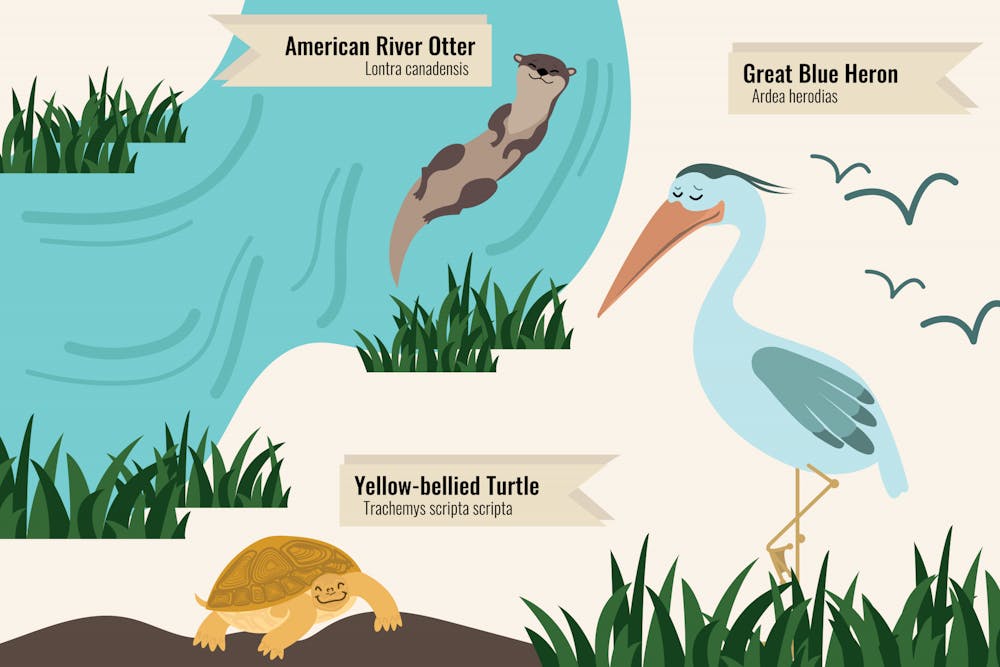Downtown Columbia may seem biologically barren at first glance. The hot asphalt and innumerable train tracks don’t paint a picture of a hospitable city to wild animals — outside of those the insects, small birds and, of course, USC’s squirrels that we associate with urban life.
At the right place during the right time, however, Columbia’s vitality becomes evident. The Congaree River, for instance, is home to many species of animal and flows directly beside Columbia.
The North American river otter is a common animal across the continent’s clean rivers, which includes the Congaree. South Carolina Wildlife Federation industry habitat manager Jay Keck called otters elusive but “fantastic predators” on the river.
“They’re going after the fish, maybe some crayfish in there as well, probably some frogs, some salamanders,” Keck said. “You have to really get out and get to know the area and try to try to figure out where the most common place is to see that, those awesome animals.”
For budding birdwatches, the great blue heron is one of several species of long-legged wading bird found on the Congaree. The largest of these species, the great blue heron can be found wading around Columbia’s rivers throughout the day and year-round. If the wading birds are not in the water, look up — many are known to make their nests as high as 60 feet off the ground.
Many of these wading birds have colored bands around their legs, marking them as participants in a Bird Banding Laboratory program. Lex Glover, a bird biologist with South Carolina’s Department of Natural Resources, runs such a program out of Fort Jackson.
Glover’s program focuses on migratory birds. The bands help keep track of birds as they migrate, helping researchers like Glover determine their success with nesting, where they choose to nest and average bird lifespan. These programs often take years to complete.
“You just need a large amount of data to begin to say anything about your data, what your data is telling you,” Glover said. “We’ve got some surveys where they've been going on for like 120-something years.”
People are encouraged to report the bird if it is seen.
For a slower-paced animal viewing, several varieties of turtle make their homes on the Congaree River as well, including the yellow-bellied slider and the Eastern box turtle These turtles can most frequently be found basking on sunny days. However, box turtles are more terrestrial (land-dwelling). Look to the sides of the river for these land-dwelling animals.
Larger reptiles, such as alligators and snakes, make their home in and along the Congaree River as well. River Runner manager Anna K. Wallace said these are some of her favorite animals to see while leading tours on the river.
“Alligators are a really fun thing for our rental customers to see, especially when they’re not from around here,” Wallace said. “Being kind of aware of your surroundings out there is very important.”
Although the venomous cottonmouth can be found in the Congaree, there are many imitators, such as the brown water snake, which Keck calls “swamp sausages” due to their length and girth. There are a few good ways to tell these nonvenomous snakes and cottonmouths apart, Keck said.
“The water moccasins don’t have these, they call them labial bars, so bars on the lips, right around the mouths … but each watersnake that we have, does have that,” Keck said.
If you find yourself face-to-face with any of Columbia’s wildlife, there are a few important things to remember — don't feed or follow the creatures.
Feeding wild animals can teach the creatures that the sight of people means a source of food, which increases their aggressivity towards humans. Following animals can make them frightened, which can lead to them getting hurt as they try to escape.
In general, Keck said, the best way to ensure wildlife continues to inhabit downtown Columbia is to give it space — especially if you see a nest.
“Think about yourself, just random people looking at you as you're raising a kid,” Keck said. “Same thing for wildlife — give them space, especially during the breeding season.”

